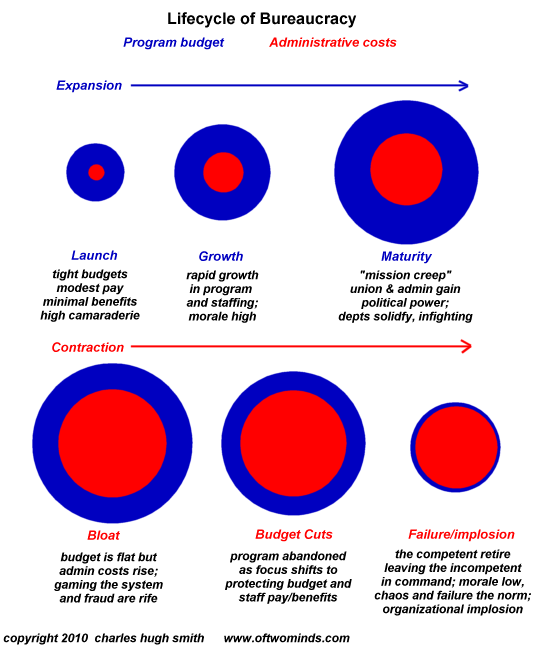When the System Thwarts Sincere, Hard-Working People, the System Has Failed
June 15, 2017
The net result is the organization fails its mission even as it adds employees and expands its budget and regulatory powers.
One of the most painfully visible symptoms of profound failure is the way our systems now thwart and frustrate sincere, hard-working people who labor within them. If you work within any of the institutions at the heart of our system--healthcare, education, governance, the armed forces, insurance, finance, and so on--or know people who work in these fields, you know most people are honest and hard-working, and trying to do a good job.
Sadly, the systems actively thwart the efforts of sincere, hard-working people and grind them down. This is true not just of employees in the lower echelons--it's equally true of top administrators.
School districts, for example, don't just chew up new teachers; they also chew up superintendents.
The key point here is this bureaucratic failure is system-wide-- it characterizes the entire status quo, and is not isolated to any one industry or sector.
It's easy to see the manifestations of systemic sclerosis and self-sabotage in every level. failed school districts hire a new superintendent every two years like clockwork, and announce "reforms" that will supposedly transform the district from a failed bureaucracy into a successful bureaucracy.
The reforms inevitably fail because the problem isn't limited to the top administrator--the entire educational bureaucracy is itself the problem. As a result, new idealistic teachers enter the system ready to do a great job educating our youth, and the best quit in disgust a few years later as the system thwarted their ability and desire to actually teach.
Those who need the pay and benefits enter a stage of resignation as the system grinds them down into a compliance that stifles innovation, risk-taking and initiative--the three essential dynamics in any successful organization, from a sprawling global military to a small local school district.
Look around, people: look at the number of teachers who are quitting, the number of senior physicians who are retiring early, the number of mid-rank military officers who are bailing out halfway in their professional career--this is a dead giveaway that the system has failed and cannot be reformed. I wrote a short book about these dynamics: Why Our Status Quo Failed and Is Beyond Reform.
Why have our systems ossified into prisons of self-sabotaging regulations and hierarchies? here are a few core dynamics:
1. Those designing the regulations and organizational structure have no skin in the game, to borrow Nassim Taleb's elevation of an old phrase. If the regulations they imposed cause the organization to fail in its core mission, they suffer absolutely no loss personally: these administrators and technocrats all retire with ample pensions and benefits regardless of the consequences of their regulatory handiwork.
2. The ontology of hierarchical, centralized organizations is to add regulations, even when they do more harm than good. as I explained in my book Resistance, Revolution, Liberation: A Model for Positive Change, Hierarchical, centralized organizations have no mechanisms for reducing their power or reach, and no mechanisms for eliminating contradictory or self-sabotaging regulations.
Why is this so? Regulators justify their positions and pay by adding regulations, not eliminating regulations. The organization itself is designed to seek to increase its budget and power; to reduce the budget and reach is anathema--it goes against the genetic wiring of hierarchical, centralized organizations.
3. Hierarchical, centralized organizations seek to centralize every aspect of the organization and its mission. The idea that individual teachers should have leeway in curriculum and teaching methods is a dangerous heresy; in hierarchical, centralized organizations, control of every individual and function must be absolute.
This is how we've ended up with enormous, sprawling institutions that are micro-managed to death.
4. The cost of complying with the ever-expanding mountain of regulations bleeds pursuit of the institution's mission. As the diagram below illustrates, these bureaucratic tropisms lead to a state in which compliance, oversight, meetings, administering penalties for non-compliance, etc. absorb more of the organization's resources than the actual pursuit of its mission.
The net result is the organization fails its mission even as it adds employees and expands its budget and regulatory powers. failure is built into any system constructed solely of hierarchical, centralized organizations. No skin in the game + no self-correcting feedback = complete and total failure.

If you found value in this content, please join me in seeking solutions by
becoming
a $1/month patron of my work via patreon.com.
Check out both of my new books, Inequality and the Collapse of Privilege ($3.95 Kindle, $8.95 print) and Why Our Status Quo Failed and Is Beyond Reform ($3.95 Kindle, $8.95 print, $5.95 audiobook) For more, please visit the OTM essentials website.
NOTE: Contributions/subscriptions are acknowledged in the order received. Your name and email remain confidential and will not be given to any other individual, company or agency.
|
Thank you, Brian E. ($5/month), for your splendidly generous pledge to this site -- I am greatly honored by your support and readership. |
Thank you, Tom ($5/month), for your magnificently generous pledge to this site -- I am greatly honored by your steadfast support and readership. |

Discover why Iím looking to retire in a SE Asia luxury resort for $1,200/month. |